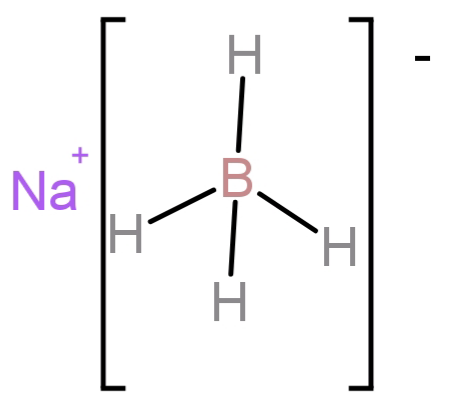
Iodine oxidises sodium borohydride to give:
A) ${B_2}{H_6}$
B) Sodium hydride
C) $HI$
D) ${I_3}^{ - 1}$
Answer
124.8k+ views
Hint: Hydrogen borohydride is a minor reducing agent. It does selective reduction and it reduces substances by transfer of hydride ions (${H^ - }$).
Complete step by step solution:
-Sodium borohydride is an organic compound with molecular formula: $NaB{H_4}$. It is a salt consisting of a tetrahedral ($B{H_4}^ - $).

-It is an effective source of nucleophilic hydride ions in polar aprotic solvents like sulfolane, DMSO, DMF, HMPA or diglyme.
- So, it acts as a minor reducing agent and does selective reduction that is it reduces aldehydes and ketones to corresponding alcohols. It does not reduce double bonds. It reduces substance by transfer of the hydride ions.
-When one sodium borohydride molecule reacts with iodine, a borane ($B{H_3}$) molecule is produced along with sodium iodide ($NaI$) and hydrogen iodide ($HI$). Hydrogen iodide then reacts with another sodium borohydride molecule producing another borane and hydrogen iodide molecule. These 2 borane molecules thus do the bridging forming diborane (${B_2}{H_6}$). This is shown in the below reaction:
$NaB{H_4} + {I_2} \to B{H_3} + NaI + HI\xrightarrow{{NaB{H_4}}}B{H_3} + HI$
-This reaction takes place in the presence of Diglyme which acts as a catalyst.
-So, this reaction can also be written as:
$2NaB{H_4} + {I_2}\xrightarrow{{Diglyme}}2NaI + {B_2}{H_6} + {H_2}$
So, the correct option is: A) ${B_2}{H_6}$
Additional information: Diborane is found to be a rocket propellant because it is highly flammable. It undergoes a highly exothermic complete combustion. But it is unable to undergo complete combustion in a rocket engine and thus produces some amount of boron monoxide ($BO$).
Note: Before attempting read the question carefully about iodine oxidising sodium borohydride and not the other way round. And do not get confused between reducing agent (donates electron) and oxidising agent (accepts electron).
Complete step by step solution:
-Sodium borohydride is an organic compound with molecular formula: $NaB{H_4}$. It is a salt consisting of a tetrahedral ($B{H_4}^ - $).

-It is an effective source of nucleophilic hydride ions in polar aprotic solvents like sulfolane, DMSO, DMF, HMPA or diglyme.
- So, it acts as a minor reducing agent and does selective reduction that is it reduces aldehydes and ketones to corresponding alcohols. It does not reduce double bonds. It reduces substance by transfer of the hydride ions.
-When one sodium borohydride molecule reacts with iodine, a borane ($B{H_3}$) molecule is produced along with sodium iodide ($NaI$) and hydrogen iodide ($HI$). Hydrogen iodide then reacts with another sodium borohydride molecule producing another borane and hydrogen iodide molecule. These 2 borane molecules thus do the bridging forming diborane (${B_2}{H_6}$). This is shown in the below reaction:
$NaB{H_4} + {I_2} \to B{H_3} + NaI + HI\xrightarrow{{NaB{H_4}}}B{H_3} + HI$
-This reaction takes place in the presence of Diglyme which acts as a catalyst.
-So, this reaction can also be written as:
$2NaB{H_4} + {I_2}\xrightarrow{{Diglyme}}2NaI + {B_2}{H_6} + {H_2}$
So, the correct option is: A) ${B_2}{H_6}$
Additional information: Diborane is found to be a rocket propellant because it is highly flammable. It undergoes a highly exothermic complete combustion. But it is unable to undergo complete combustion in a rocket engine and thus produces some amount of boron monoxide ($BO$).
Note: Before attempting read the question carefully about iodine oxidising sodium borohydride and not the other way round. And do not get confused between reducing agent (donates electron) and oxidising agent (accepts electron).
Recently Updated Pages
Types of Solutions - Solution in Chemistry

Difference Between Crystalline and Amorphous Solid

JEE Main Participating Colleges 2024 - A Complete List of Top Colleges

JEE Main Maths Paper Pattern 2025 – Marking, Sections & Tips

Sign up for JEE Main 2025 Live Classes - Vedantu

JEE Main 2025 Helpline Numbers - Center Contact, Phone Number, Address

Trending doubts
JEE Main 2025 Session 2: Application Form (Out), Exam Dates (Released), Eligibility & More

JEE Main Exam Marking Scheme: Detailed Breakdown of Marks and Negative Marking

JEE Main 2023 January 24 Shift 2 Question Paper with Answer Keys & Solutions

Learn About Angle Of Deviation In Prism: JEE Main Physics 2025

JEE Main 2025: Conversion of Galvanometer Into Ammeter And Voltmeter in Physics

JEE Main Login 2045: Step-by-Step Instructions and Details

Other Pages
NCERT Solutions for Class 11 Chemistry Chapter 7 Redox Reaction

NCERT Solutions for Class 11 Chemistry Chapter 5 Thermodynamics

JEE Advanced Marks vs Ranks 2025: Understanding Category-wise Qualifying Marks and Previous Year Cut-offs

NCERT Solutions for Class 11 Chemistry Chapter 8 Organic Chemistry

NCERT Solutions for Class 11 Chemistry Chapter 6 Equilibrium

NCERT Solutions for Class 11 Chemistry Chapter 9 Hydrocarbons




